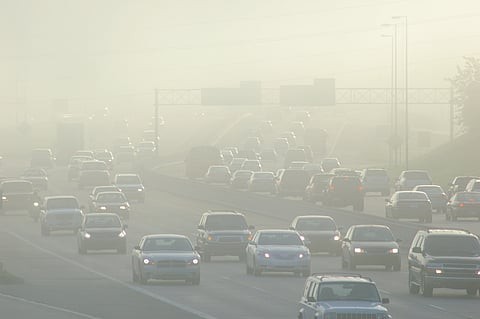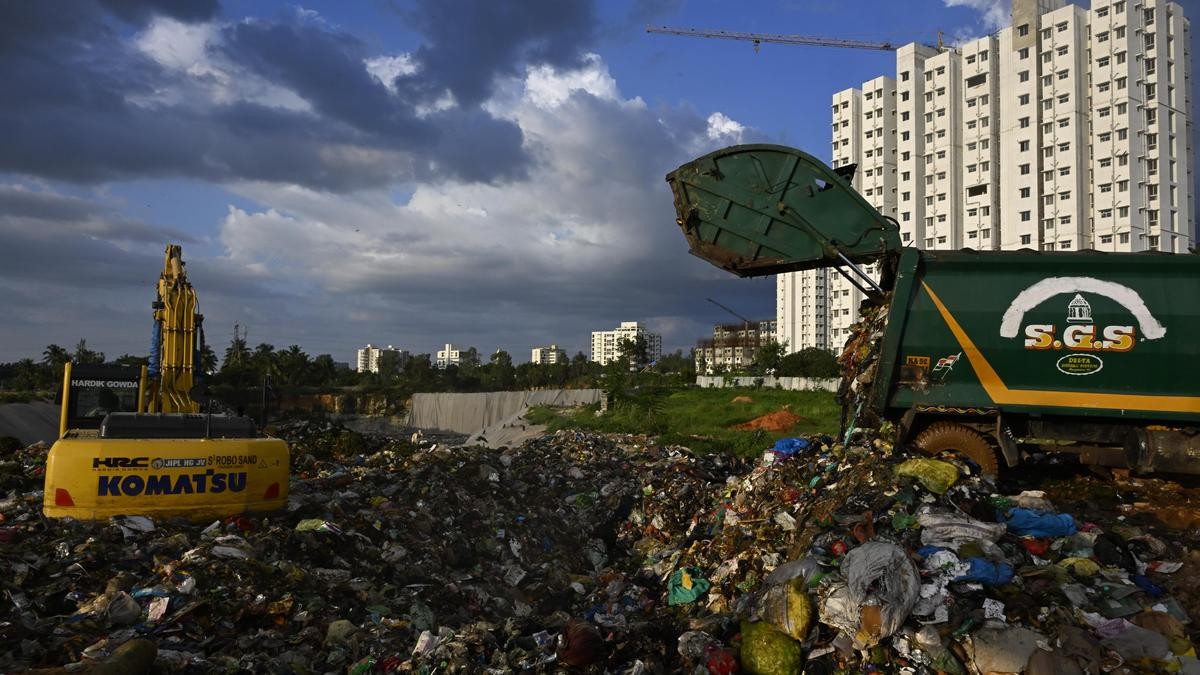




Source: TIMES OF INDIA
Disclaimer: Copyright infringement not intended.
India Meteorological Department (IMD) has issued a yellow alert for a heatwave in Delhi on April 25–26 forecasting maximum temperatures between 40–42°C with clear skies, dry westerly winds & sustained poor air quality despite slight improvements across Delhi-NCR.
|
Criteria |
Threshold Value |
Remarks |
|
Maximum Temperature ≥ 40°C |
With departure of ≥ 4.5°C to 6.4°C |
Heatwave |
|
Maximum Temperature ≥ 40°C |
With departure of > 6.4°C |
Severe Heatwave |
|
Absolute Maximum Temperature ≥ 45°C |
Irrespective of normal |
Heatwave |
|
Absolute Maximum Temperature ≥ 47°C |
Irrespective of normal |
Severe Heatwave |
|
Minimum Temperature Influence |
Not considered directly |
But contributes to thermal stress during heatwave spells |
|
Duration |
Usually 2 or more consecutive days |
But warning may be issued even for 1 day in exceptional cases |
|
AQI Range |
Color Code |
Category |
Associated Health Impacts |
|
0 – 50 |
Green |
Good |
Minimal or no health risk. Air quality is considered satisfactory. |
|
51 – 100 |
Light Green |
Satisfactory |
Acceptable; may cause minor breathing discomfort to sensitive individuals. |
|
101 – 200 |
Yellow |
Moderate |
Breathing discomfort to people with asthma, heart disease, elderly & children. |
|
201 – 300 |
Orange |
Poor |
Increased likelihood of respiratory symptoms among sensitive groups. |
|
301 – 400 |
Red-Purple |
Very Poor |
Respiratory illness on prolonged exposure; affects general public health. |
|
401 – 500 |
Maroon |
Severe |
Serious health effects even on healthy people; emergency conditions for sensitive groups. |
|
Alert Type |
AQI Range |
Description |
Health Advisory |
|
No Alert |
0 – 50 |
Air quality is considered satisfactory with little or no risk to general population. |
No action required. |
|
Moderate |
51 – 100 |
Air quality is acceptable; however there may be some health effects for sensitive individuals (e.g. asthma or breathing issues). |
People with respiratory conditions should limit prolonged exertion outdoors. |
|
Unhealthy for Sensitive Groups |
101 – 200 |
Health effects may be felt by sensitive individuals such as children, elderly people & those with respiratory or heart conditions. |
Sensitive individuals should avoid prolonged outdoor activities. |
|
Unhealthy |
201 – 300 |
Health effects are likely to occur for general population not just sensitive groups. Outdoor activities should be limited. |
Everyone may begin to experience health effects; sensitive individuals should avoid outdoor exertion. |
|
Very Unhealthy |
301 – 400 |
Health alert. Everyone may experience more serious health effects. |
Everyone should avoid outdoor activities; stay indoors with air conditioning. |
|
Hazardous |
401 – 500 |
Emergency conditions. Serious health effects for entire population. |
All individuals should remain indoors & avoid physical activities. |
A Western Disturbance (WD) refers to an extratropical storm that originates in Mediterranean region or North Africa & moves eastward across Middle East & northern Indian subcontinent primarily affecting India, Pakistan & Nepal.
|
Aspect |
Description |
|
Origin |
Mediterranean & North African regions where warm & moist air meets cold air from polar regions. |
|
Nature |
These disturbances are low-pressure systems & are responsible for bringing rainfall & colder conditions. |
|
Movement |
They generally travel eastward from Mediterranean crossing Iran, Afghanistan & Pakistan into northern India. |
|
Impact on Weather |
WD brings rain to northwestern & northern India (Punjab, Haryana, Delhi, Himachal Pradesh, Jammu & Kashmir) & can cause fluctuations in winter temperatures. |
|
Duration |
Typically these disturbances last 3-5 days & affect western Himalayan region with varying intensities. |
|
Precipitation Type |
The precipitation associated with Western Disturbances is mostly light to moderate rainfall or snowfall in hilly areas although heavy rainfall may occur in some cases. |
|
Seasonality |
Predominantly observed during winter season (from October to March) with some weakening or absence during summer monsoon months. |
|
Influence on Indian Climate |
WDs are crucial for winter precipitation in northwestern & northern India & play a significant role in maintaining agricultural productivity of these regions. |
|
Thunderstorms |
WDs also bring thunderstorms particularly in plains of northern India often associated with sudden temperature drops & shifting wind patterns. |
Impact of Western Disturbance (WD) on India
Snowfall in Himalayas WDs cause snowfall in higher altitudes of western Himalayas, which affects water resources in region.
Rainfall in Plains Regions like Delhi, Punjab, Haryana & Uttar Pradesh receive rainfall often leading to a sudden drop in temperatures.
Temperature Variations WDs can cause sharp fluctuations in temperatures with warm spells followed by cold spells. They can also lead to fog & low visibility during winter months.
Cyclonic Storms: In certain instances if disturbance intensifies it can lead to cyclonic storms though this is rarer.
Thunderstorms in East India including states like Odisha, West Bengal, Bihar, Jharkhand & parts of Uttar Pradesh are typically linked to warm, moist air & significant atmospheric instability. These storms are particularly active during pre-monsoon & monsoon months.
Key Characteristics of Thunderstorms in East India
|
Aspect |
Description |
|
Formation |
Thunderstorms in East India generally form due to convergence of moist air from Bay of Bengal & hot, dry air from north. The region experiences frequent occurrences of low-pressure areas. |
|
Seasons |
Thunderstorms are most common during pre-monsoon season (March to June) & monsoon season (June to September). However they can occur in post-monsoon period as well. |
|
Conditions Favoring Formation |
High surface temperatures, moisture availability from Bay of Bengal & atmospheric instability are key ingredients for thunderstorm development. |
|
Wind Patterns |
Strong easterly winds coupled with influx of moisture from Bay of Bengal help in creating conditions for thunderstorms. |
|
Intensity |
These thunderstorms can be severe often producing heavy rainfall, strong winds (30-60 km/h), lightning & occasionally hail. |
|
Tornadoes |
Tornadoes are rare but can occur especially with intense thunderstorms in this region. |
|
Duration & Frequency |
Thunderstorms typically last for 1-2 hours but can be frequent in summer months especially in region’s hilly terrain & coastal areas. |
|
Impact on Weather |
The thunderstorms bring much-needed rain to agricultural regions of East India but can also result in localized flooding, property damage & loss of life. |
|
Rainfall |
Thunderstorms often lead to heavy & localized rainfall which can cause flash floods particularly in hilly areas. |
|
Lightning |
Lightning strikes are frequent & can cause fires, power outages & injuries especially in rural & agricultural areas. |
Development of Low-Pressure Areas Low-pressure areas or cyclonic circulations over Bay of Bengal can significantly enhance thunderstorm activity by strengthening convergence of air masses.
Influence of Sea Breeze The sea breeze from Bay of Bengal plays a critical role in triggering convection particularly in coastal regions like Odisha & West Bengal where afternoon thunderstorms are common.
Convection & Instability High temperature gradients between land & sea cause vertical convection resulting in upward movement of warm, moist air. As air rises, it cools, condenses & forms clouds leading to thunderstorm activity.
Thunderstorms & Crop Damage These storms often lead to damage of standing crops due to strong winds, hail & flooding. The region heavy reliance on agriculture makes these storms both a boon (for rainfall) & a bane (for crop destruction).
Key Meteorological Factors Affecting East India Thunderstorms
Sea Surface Temperatures (SSTs) Warm SSTs in Bay of Bengal increase moisture content in air enhancing thunderstorm development.
Atmospheric Instability A sharp contrast between warm surface air & cooler air aloft fosters conditions for deep convection & thunderstorm formation.
Low-Level Jet Streams The presence of low-level jet streams which transport moisture into region is crucial for intensity of these thunderstorms.
|
Aspect |
Impact on Delhi Weather |
Details |
|
Temperature Variations |
Sudden Drop in Temperature |
WDs cause cold northerly winds leading to a sharp decrease in temperature particularly during winter months. |
|
Precipitation |
Light to Moderate Rain |
Light rainfall often intermittent caused by WDs passing over Delhi. Rainfall can last over a few days increasing humidity levels. |
|
Fog Formation |
Dense Fog |
WDs lead to foggy conditions especially in mornings due to drop in temperature & high humidity. |
|
Hailstorms |
Occasional Hailstorms |
WDs may occasionally cause hailstorms in Delhi especially during winter though this is rare. |
|
Wind Patterns |
Cold Westerlies, Gusty Winds |
Strong westerly winds reduce temperatures & may bring brief gusts of rain followed by clear skies. |
|
Visibility |
Reduced Visibility (Fog) |
The fog reduces visibility especially in early mornings which can affect air & road transport. |
|
Aspect |
Impact on Delhi Weather |
Details |
|
Temperature Variations |
Hot & Humid Conditions |
Thunderstorms from East India bring warm, moist air to Delhi raising temperatures & increasing humidity particularly before or during thunderstorms. |
|
Precipitation |
Unpredictable Rainfall |
Brief, sudden rainfall occurs in Delhi especially in pre-monsoon months but is usually lighter compared to eastern states. |
|
Humidity |
Increased Humidity |
The moist air from East India thunderstorms causes a rise in humidity levels leading to uncomfortable conditions especially during pre-monsoon months. |
|
Air Quality |
Deterioration in Air Quality |
Humidity & rising temperatures can exacerbate pollution levels, causing smog & haze & occasionally dust storms. |
|
Heat Index |
Higher Apparent Temperature |
Due to increase in humidity, heat index (feels-like temperature) is higher than actual temperatures making it feel hotter. |
|
Dust Storms |
Higher Dust Concentration |
Strong winds from thunderstorms may carry dust & particulate matter into Delhi worsening air quality. |
For more such articles, please refer to IAS GYAN
Sources:
|
PRACTICE QUESTION Q. Discuss how Western Disturbances & East India-origin thunderstorms differently impact weather patterns of Delhi particularly in terms of temperature, precipitation & air quality. |







© 2025 iasgyan. All right reserved